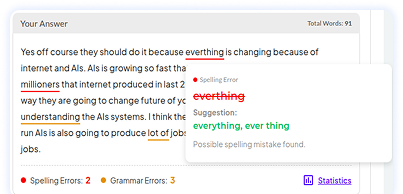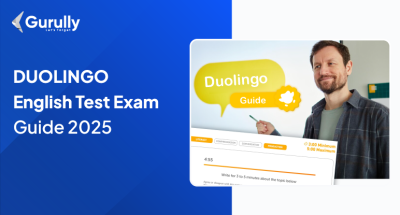As Duolingo exam is getting wide acceptance, they are constantly making changes to make the exam experience more convenient and better. Recently, new changes have been introduced in Duolingo Interactive speaking questions. This update is applicable for those who are taking the DET exam on 1st July 2025 or afterward. So, if you are taking this exam, then here is everything you need to know about the Duolingo interactive speaking section.
What is Duolingo Interactive Speaking Questions?
Duolingo Interactive Speaking has question types that test your spontaneous speech, ability to organize thoughts quickly, and overall spoken fluency in English.
What’s Changed in the DET Speaking Section?
- More Natural Interaction: Interactive Speaking mimics real-life exchanges. In these newly added questions, you will encounter an audio segment in which you must engage continuously, just as you would in a regular conversation.
- Adaptive Depth: Every question asked is taken from your previous response. If you express an opinion, the subsequent follow-up digs deeper, mirroring a genuine conversation. By this, how well you think, respond, and adapt is evaluated.
- Efficient Test Design: By eliminating Read Aloud, the DET maintains its original duration while adding a richer, more communicative Speaking experience.
Duolingo Interactive Speaking Format:
- Series of 6–8 questions: Each delivered by an animated character.
- Time limit: 35 seconds per answer—enough for a structured response.
- Adaptive flow: Questions are dynamically selected based on your prior answers
- Scoring impact: Counts towards both your overall Duolingo English Test score and speaking subscore
By blending structure with spontaneity, you demonstrate both proficiency and conversational adaptability.
Why It Matters
- Even though this task is ungraded, it’s crucial for admissions. Here’s why:
- Admissions officers can hear your actual voice and communication style
- Helps verify the authenticity of test performance
- Can make your application stand out, especially if you’re applying for a communication-focused course
Duolingo Interactive Speaking Preparation Tips:
Use a Simple Structure
Stick to a clear structure to avoid rambling:
- Introduction – Briefly introduce your opinion or point of view.
- Main Point 1 – Explain with a reason or detail.
- Main Point 2 – Give a supporting example or contrast.
- Conclusion – Restate your view or give a final thought.
Don’t Aim for Perfection, Aim for Clarity
- Fluency matters more than using complex words. Speak smoothly and confidently. Pausing naturally is fine—just avoid freezing or repeating too often.
Practice Spontaneous Speaking
Simulate the 30-second prep +90-second talk using random topics. You can even use a stopwatch and record yourself.
Example prompts to practice:
- “Describe a person who inspires you.”
- “Do you prefer city life or rural life?”
- “What’s one skill every student should learn?”
Use Transition Phrases
Keep your ideas organized with helpful phrases:
- “First of all…”
- “For example…”
- “On the other hand…”
- “To conclude…”
Keep Your Vocabulary Practical
- Avoid overcomplicating. Use words you’re comfortable pronouncing well. Clarity and confidence win over complexity.
Sample Duolingo Interactive Speaking Questions With Answers:
Interactive Speaking Sample Set 1
Character (Q1):
Hi! Let’s get to know each other. Can you tell me about a hobby you enjoy and why you like it?
Your Response (A1):
“I enjoy gardening. It helps me relax and feel connected to nature. I also love watching the plants grow—it’s rewarding and calming after a busy day.”
Character (Q2):
That sounds peaceful! What challenges did you face when starting this hobby?
Your Response (A2):
“When I started, I didn’t know how to care for plants properly. I overwatered some and placed others in the wrong spot. Over time, I learned by reading and watching videos.”
Character (Q3):
Do you think more people should take up gardening? Why or why not?
Your Response (A3):
“Yes, especially people living in cities. It reduces stress and teaches patience. Even a small balcony garden can make a big difference in someone’s mood.”
Interactive Speaking Sample Set 2
Character (Q1):
Let’s talk about learning. What’s something new you’ve learned recently?
Your Response (A1):
“I recently started learning how to cook Indian dishes. I’ve always enjoyed the flavors, and now I’m trying to recreate them myself using online tutorials.”
Character (Q2):
Nice! What’s one dish you’ve made that turned out really well?
Your Response (A2):
“I made butter chicken last week, and it came out great. The recipe was complex, but I followed each step carefully and was proud of the result.”
Character (Q3):
Would you like to learn more types of cuisine in the future?
Your Response (A3):
“Yes, definitely. I’d love to try Thai and Japanese recipes next. Cooking different cuisines teaches me about culture, spices, and new techniques.”
Interactive Speaking Sample Set 3
Character (Q1):
Let’s talk about travel. Can you describe a trip you took that was especially memorable?
Your Response (A1):
Last year, I visited Istanbul with my friends. The city’s mix of European and Asian culture was fascinating. I especially enjoyed exploring the Grand Bazaar and taking a boat ride on the Bosphorus. The food and architecture were unforgettable.
Character (Q2):
What made that trip different from other places you’ve visited?
Your Response (A2):
I think it was the history. Seeing landmarks like the Hagia Sophia and the Blue Mosque made me feel like I was stepping into the past. The people were also very welcoming, which made the experience even more enjoyable.
Character (Q3):
Would you recommend Istanbul to someone who’s never traveled abroad before? Why or why not?
Your Response (A3):
Yes, I would. It’s a great place for first-time travelers because it’s both exciting and easy to navigate. There’s a lot to see, and most people speak English, which makes communication smooth. It offers a rich mix of culture and comfort.
Interactive Speaking Sample Set 4
Character (Q1):
Tell me about a time when you helped someone. What was the situation?
Your Response (A1):
A few months ago, I helped a neighbor who had broken her leg. She needed assistance with groceries and getting to appointments. I offered to drive her once a week and pick up anything she needed from the store.
Character (Q2):
How did that experience affect your relationship with your neighbor?
Your Response (A2):
We became much closer. Before that, we barely spoke, but now we chat regularly and check in on each other. Helping her not only made her life easier but also created a sense of trust and community between us.
Character (Q3):
Do you think small acts of kindness can have a big impact?
Your Response (A3):
Absolutely. Even simple things like offering help or listening to someone can improve their day. Small actions often lead to stronger relationships and a more supportive environment for everyone.
Interactive Speaking Sample Set 5
Character (Q1):
What’s your favorite way to relax after a long day, and why?
Your Response (A1):
After a long day, I usually unwind by reading fiction. It helps me disconnect from stress and enter a different world. I find it calming and mentally refreshing, especially when the story is really engaging.
Character (Q2):
Have your relaxation habits changed over the years? How?
Your Response (A2):
Yes, earlier I used to play video games, but now I prefer quieter activities like reading or going for a walk. I’ve realized that silence and solitude help me recharge better than screen time.
Character (Q3):
Do you think people today find it harder to relax than in the past?
Your Response (A3):
Yes, mainly because of constant notifications and busy schedules. It’s harder to disconnect. People are always online or multitasking. I believe it’s essential to establish boundaries and make time for genuine relaxation.
To achieve a high score in Duolingo’s Interactive Speaking section, consistent practice is essential. Gurully offers full-length mock tests designed to help you prepare in a structured and effective manner. Our tests closely simulate the actual exam environment, allowing you to build confidence and manage real test-day pressure with ease. Gurully’s Full-length mock tests provide accurate, instant scoring to give you reliable feedback.
Start your free DET mock test with Gurully and get AI-powered analysis for a personalized journey.


- Kickstart your DET prep with a free AI-scored mock test
- Boost your score with in-depth analysis & smart recommendations
Conclusion:
The updated Duolingo Interactive Speaking section is designed to evaluate how naturally and effectively you can express yourself in real-time conversations. While this task may not directly impact your score, its significance in university admissions cannot be overlooked—it showcases your actual speaking ability and personality.
By understanding the new format, using structured responses, and practicing regularly with tools like Gurully’s expert-designed DET mock tests, you can boost both your confidence and performance. Start your preparation today to stay ahead and make a strong impression in your Duolingo English Test.
FAQs
Does Duolingo have a speaking part?
What is interactive reading in Duolingo?
How do I practice Duolingo speaking test?
Is 70 a good Duolingo score?
Can I speak during Duolingo test?
Also Read:
- Duolingo Listen and Respond: Explained with Tips & Sample Question
- Duolingo Listen and Type Guide To Score High With 40+ Sample Question
- Duolingo Read and Complete Task: Format & Sample Question With Answer





